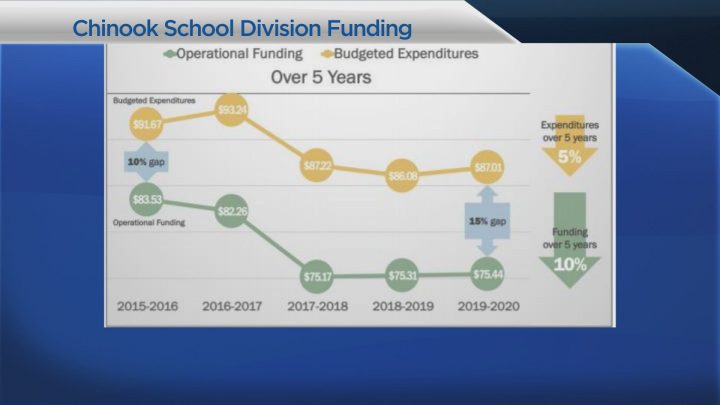As another school year draws to a close, school divisions across Saskatchewan are in the midst of finalizing their budgets for the 2019-20 school year.

While a majority of the province’s school divisions saw their provincial funding increase, the Saskatchewan School Board Association president Shawn Davidson has been hearing about another tight year.
“We’re well aware that there are going to be some cutbacks and there are going to be some changes that are the result of just once again with funding that did not keep pace with the cost pressures school divisions face,” he said.
This includes the Chinook School Division, which serves Swift Current and area. The division has made about $6 million in budget cuts, since losing $7 million in provincial funding in 2017.
“We did everything we could in our division to find efficiencies. Now we feel we’re in a place where there are no more efficiencies to be found,” Chinook School Division board chair Kimberly Pridmore said.
“We turned over every stone we could to find them, and we did that in an effort to keep the cuts out of the classroom, so it doesn’t affect students more than necessary. But we’re at a place now where we have nowhere left to go.”
Chinook’s expenses are pegged at $87 million for the 2019-20 school year. Their operating grant and tax revenue total $82.15 million, leaving a $4.8 million deficit. This will partially be covered by drawing $2.28 million from reserves.
- Life in the forest: How Stanley Park’s longest resident survived a changing landscape
- ‘Love at first sight’: Snow leopard at Toronto Zoo pregnant for 1st time
- Carbon rebate labelling in bank deposits fuelling confusion, minister says
- Buzz kill? Gen Z less interested in coffee than older Canadians, survey shows
Pridmore said they’re challenged because enrolment figures have remained flat for the past few years, and that figure plays a significant role in the school division funding formula.
While the student body has not grown, the costs of running the division have. The division’s newsletter outlines added spending in negotiated salary increases ($527,000), energy ($310,000) and bus replacement ($1.06 million).
“The gap keeps widening because we just don’t have the increase in enrolment to attract more of the revenue from the government,” Pridmore said.
Pridmore said they can’t control certain costs like heat and busing, both essential in the small rural schools that fall under Chinook’s jurisdiction.
“They’re not filled to capacity by any stretch, but we have to heat them and cool them and maintain them regardless of the number of kids and staff in there,” Pridmore said.
Even Saskatchewan’s largest school division, Saskatoon Public School Division, is feeling the fiscal pinch.
That board will hold its budget deliberations on June 19, which includes a $3.5 million funding boost. However, their budget document notes this represents only a 1.57 per cent increase over 2016-17 funding.
In that time, the division added 752 students. That represents three per cent growth in the student body since the $54 million provincial classroom funding cut in the 2017-18 Saskatchewan budget.
To accommodate growing classrooms, the proposed budget includes adding 15 full-time equivalent (FTE) teaching positions, 17.5 educational assistant FTEs and two special education program teachers.
There are planned cuts, however. This includes 15 English as an additional language FTEs, 18.8 teacher librarian positions, and Grade 8 home economics and industrial arts. That class cut represents four FTEs.
The planned budget includes pulling $1.5 million from operational reserves to help balance the books.
Since the provincial budget was delivered, the Saskatchewan government defended education funding, saying it represents the biggest investment in provincial history.
“Every year should be a record investment because there’s more kids now, there’s more costs, so of course the costs are going to escalate from one year to the next,” Davidson said.
“The fact of the matter is we’re only back to where we were when school divisions faced the $54 million cut, as far as the overall funding envelope goes. In that time there’s thousands more students.”
School divisions have until June 30 to submit their budgets to the Ministry of Education for final approval.



Comments